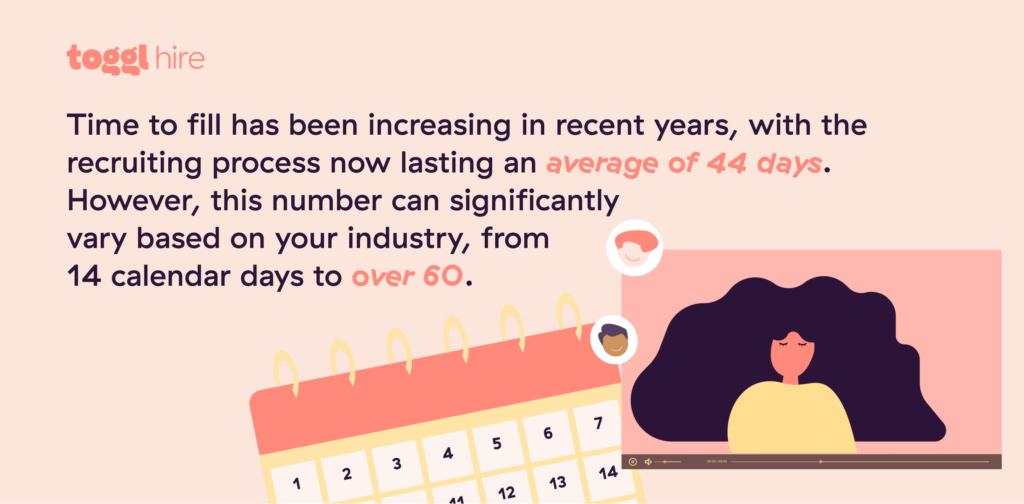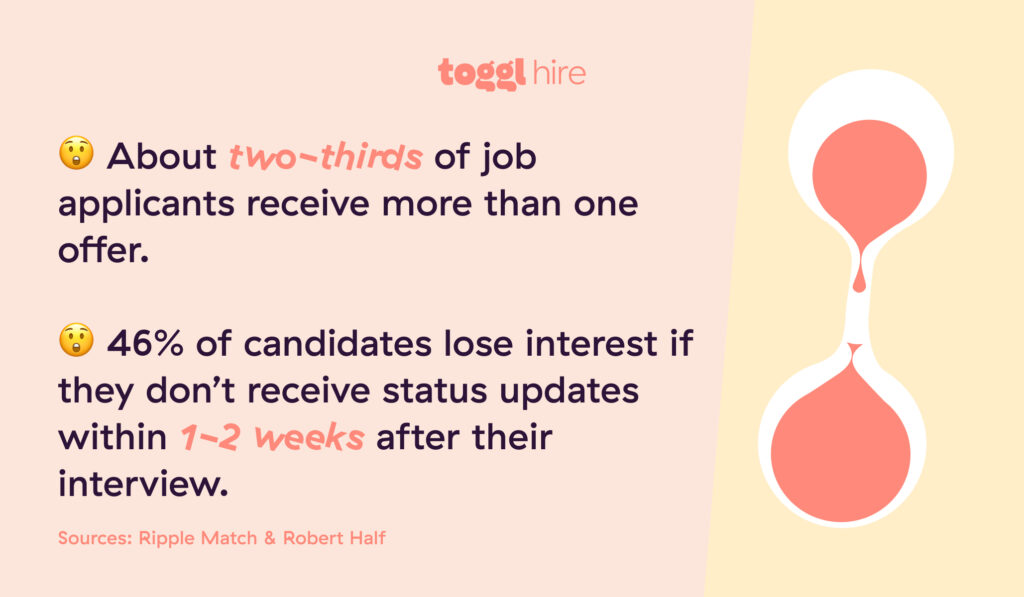Time to fill is a key recruiting metric that every hiring manager should be familiar with, as it measures the efficiency of the hiring process from the time the hiring manager submits the job requisition (or creates the job post) until the candidate accepts the position.
Beyond numbers, it provides a snapshot of the effectiveness and challenges of your recruitment strategy. Most hiring teams use it as the key performance indicator (KPI) of the company’s ability to attract and retain top talent and a reflection of its overall talent acquisition process.
It’s not just about filling positions quickly, though (which is obviously great for the candidate experience but can lead to poor hires if the process is too rushed). Improving your time to fill can significantly enhance the recruitment process, increase the quality and quantity of candidates, and drive business growth.
So, let’s unpack what it entails, how it’s calculated, and why it’s so vital in the recruitment process.
TL;DR — Key Takeaways
Time to fill tracks the entire recruitment cycle from job posting to acceptance. Time to hire measures the period from application to offer acceptance. Both metrics assess the efficiency of the hiring process.
According to a survey conducted by SHRM, the average time to fill a position in the US is 44 days. However, the ideal time to fill varies based on industry, technology advancements, location, and organizational needs.
By accelerating time to fill, companies can streamline their hiring processes, leading to significant cost savings from reduced recruitment efforts, minimized job vacancy periods, and an enhanced ability to attract top talent.
Aligning the hiring process with business goals is important for enhancing operational efficiency and financial stability. By using modern HR tools, you can automate and optimize hiring, ensuring a balance between swift talent acquisition and informed decision-making.
What is time to fill in recruitment?
As the guiding star in most recruitment processes, time to fill is a crucial recruiting metric that determines the efficiency and effectiveness of your hiring process. It refers to the number of days it takes to fill a job opening, from the moment it’s posted to when the offer is accepted.
This is important because a super long time to fill can lead to a loss of potential revenue and a decrease in productivity. Additionally, it can also impact candidate experience and feelings about your organization. The longer your recruitment process takes, the higher the chances of top candidates losing interest and applying elsewhere.
It’s essential to strike the right balance between taking the necessary time to make informed and strategic hiring decisions and ensuring that you don’t keep qualified candidates waiting too long. Theo only way you’ll be able to strike that balance is by tracking and optimizing time to fill to see where you can improve your hiring process and ultimately deliver better business outcomes.
| ASPECT | SHORTER | LONGER |
| Efficiency | Indicates a streamlined hiring process | Suggest potential inefficiencies or bottlenecks |
| Attractiveness to Candidates | Enhances chances of securing top talent swiftly | Increases risks of losing qualified candidates to competitors with faster hiring processes |
| Cost | Typically results in cost savings | Leads to increased hiring and vacancy costs |
| Impact on Team | Ensures minimal disruptions in teams | Can strain existing teams (in terms of both morale and productivity) |
| Employer Branding | Boosts the company’s image as efficient and desirable | Might reflect negatively on the company’s hiring strategy and employer brand |
How do you calculate time to fill?
The time to fill calculation or the time to fill formula is straightforward. You just need to calculate the time it takes for you to fill an open position — from the moment you publish the job description to the second a new hire accepts an offer.
Let’s say you posted a job, and 25 days later, a candidate accepted your proposal. Your time to fill is 25 days. Want to calculate average time to fill across various departments? Add together the fill time for multiple roles and divide by the number of positions filled. For example, if you filled three roles in 20, 30, and 40 days, respectively, your average is (20+30+40)÷3, so 30 days.
Ultimately, it’s up to your recruiting operations team to define when the clock starts when measuring time to fill metrics. Generally speaking, it starts the moment the job post goes live, but some internal teams might decide it starts the moment a job requisition is created or the team receives approval to hire for the job.
If your company continuously has open positions as part of ongoing recruitment efforts or mass hiring drives, don’t count those towards your time to fill calculations, as they will inflate the average time and distort the data.
Time to fill vs. time to hire
Although time to fill and time to hire seem interchangeable, they’re distinct recruitment metrics that provide insight into different aspects of the hiring process.
Time to fill offers a panoramic view of the whole hiring journey — from the moment a company announces a role to vetting potential new hires and sealing the deal with a job offer.
In contrast, time to hire measures more of the candidate assessment and decision-making aspects of the recruitment process. Time to hire includes everything that occurs once the candidate applies up until the candidate accepts an offer.
| Metric | Definition | Responsibility | Importance |
| Time to Fill | The duration of the hiring process, from the time you post a job to when you finish candidate onboarding | Hiring team or HR | Highlights how fast and skillfully a company can attract and select talent |
| Time to Hire | The duration of the candidate’s experience, from the date they send their initial application to the date they accept the offer | Hiring manager | Reveals the speed of decision-making and how well candidates are evaluated |
While both time to fill and time to hire measure efficiency, they focus on different stages of the recruiting process. Their importance varies based on your company’s specific goals and challenges in the hiring landscape.
So, who monitors what?
Time to fill is monitored by the recruiting team or HR department. They oversee the recruitment process, including advertising jobs, screening candidates, and handling hiring logistics. Time to hire is linked to candidate selection and is typically overseen by the hiring manager, as they directly engage in evaluating candidates and making the final hiring decisions.
A shorter time to fill indicates an efficient, streamlined process. It stresses the company’s capacity to fill an empty position promptly, ensuring continuous business flow. A shorter time to hire, on the other hand, demonstrates effective assessment and decision-making skills and highlights your company’s ability to quickly target, test, select, and onboard great candidates.
What’s a good benchmark for time to fill?
In the past four years, it’s been taking increasingly longer for companies to hire new employees, with the recruiting process now lasting an average of 44 days. However, this number can significantly vary based on your industry, from 14 calendar days to over 60.
According to AMS and The Josh Bersin Co., there’s recently been an increase in the time employers need to fill open jobs due to a more complicated hiring landscape. There are several reasons for this spike in the average calendar days for time to fill:
The Great Resignation, which has led to a shortage of qualified candidates.
Widening skills gap due to employers looking for more specialized skills in candidates and the rapid advancement of technology.
Rise in remote work, as candidates are job-seeking nationally and internationally, which makes the talent pool more competitive.
The use of ATS (applicant tracking systems), which, although effective in filtering out unqualified hires, is often time-consuming and increases the workload for human resource management teams.

In 2023, 9 in 10 hiring managers faced challenges finding skilled talent. Whether due to the widening skills gap or the use of outdated recruitment software that causes bottlenecks in the process, it’s important to understand for which jobs and why fill time is so high.
Are there too many steps in the process? Are you attracting the wrong candidates? Is your hiring team late to follow up and schedule interviews? Is there a lack of leadership within the hiring team that’s leading to poor decision-making or indecisiveness?
Use those answers to get a more accurate representation of the efficiency of your hiring team. Industry benchmarks for time to fill, like other recruiting metrics, will offer a quick reference point for you to measure your company against others in your industry.
As you analyze your company’s average time to fill and begin comparing it to other time to fill benchmarks, consider the following:
Ensure you’re looking at current data and the job descriptions are accurately matched. Otherwise, you’re in for misguided strategies.
Consider the size of your company and its geographical location when reading into the benchmarks. These factors can highly influence hiring times and process, which requires a custom approach
Keep an eye out for sudden industry changes. Adapting to those shifts quickly helps your company to stay competitive.
Consider your company’s internal and external factors. This allows an effective recruitment process and to better understanding of your company’s position in the industry.
What’s a good average time to fill?
When examining the average time to fill across different industries and positions, it gives you valuable, actionable insights. It helps fine-tune hiring strategies, making sure they’re efficient and effective. Factors to consider are industry-specific averages, position levels, and staying up to date with the current, relevant data for better decision-making.
It’s important to acknowledge the gap between top-performing recruiters and lower-performers. While top performers take an average of 34 days to fill a position, the lower-performing teams take up to 91 days to do the same task.
However, this average time can be skewed depending on various factors, such as “low-performing” teams not having the tools needed to recruit and assess efficiently, poorly written job descriptions, a lack of benefits to attract the best candidates, and more.
The average time to fill by industry
Here’s a breakdown of time to fill by industries, measured in days:
Energy & Defense: 67
Engineering: 62
Investment Banking: 60
IT: 41
Tech & Media: 20
Professional Services: 47
Automotive: 16
Cleaning Services: 14
Education & Child Care: 18
Fitness: 22
Healthcare: 18
Home & Commercial Services: 17
Hospitality: 14
Personal Care: 17
Restaurant & Food Services: 18
Retail: 18

The average time to fill by seniority
Below are a few examples of time to fill at the job category level, measured by days:
Executive Level: ~120
Director Level: ~90
Senior Leadership: ~75
Mid-Senior Level: ~60
Manager: 75
Sales Staff: 53
Associate Level: Mid-Senior Level: ~60
Professional Staff: 48
Operations Staff: 48
Service Staff: 35
Entry Level: ~30
Support Staff: 28
Administration: 24
While comparing your company’s average time to fill to other companies in the same industry, it’s ultimately important to compare your current time to fill with previous averages to ensure you’re constantly optimizing your recruiting funnel to improve candidate experience, reduce bottlenecks, and improve hiring efficiencies.
How does time to fill impact the hiring process?
For most companies, improving time to fill is necessary as part of hiring the best talent, improving candidate experience, and saving money throughout the recruitment process. When optimizing the valuable input metric, most companies experience the following benefits.
Smoother hiring
When you reduce time to fill by implementing better hiring practices, skills testing, and other tactics, your company can quickly find and hire the right people to fill a position. To candidates, this demonstrates that the business has a good process in place for finding and hiring employees, which correlates with the overall health and efficiency of the company.
Consistent production
When an employee leaves or is let go, it can cause severe dips in productivity, especially if their role is mid-senior or senior-level. When your team works to hire quickly and efficiently, you’re able to keep production levels consistent without dropping the ball on any big projects, ensuring no extra pressure is put on the team when someone leaves or a new job opening is created.
Attract top talent
Top candidates usually have several job options, so they won’t wait around for a long time to hear back about a job. By extending a job offer quickly (and is known for that swiftness and professionalism), your company attracts the best talent pool, as there’s a higher chance of getting highly sought-after candidates to join your team.
The drawbacks of a longer time to hire
Hiring managers are reporting that it takes an average of 11 weeks to fill a position, which is up from 7 weeks in 2021. When it takes too long to fill open jobs, it will cause several problems for your company, including the following.
Missing out on good talent
About two-thirds of job applicants receive more than one offer. If your hiring process takes too long, candidates will lose interest and accept an offer elsewhere. To avoid losing talent to competitors, focus on quality over quantity.
Unproductive, unhappy teams
When it takes months to fill one position, the existing employees usually end up doing extra work to cover for the missing person. This creates bottlenecks, affects workflows, and can lead to burnout. In worst-case scenarios, it can make more people leave your company.
Increased hiring costs
The more valuable time you spend looking for a new hire, the more money you spend on things like job ads and the interviewing process. All of this eats into hiring budgets and takes away from other important work, increasing costs across the board.
10 most effective strategies to reduce time to fill
Struggling to extend a job offer on time? Having trouble crafting the perfect job post that helps attract qualified candidates who are actually a good fit for the roles you need to fill? Here are ten top tips from our experts on how to reduce time to fill and time to hire.

1. Strengthen your company image
A strong employer brand can greatly reduce hiring time by attracting quality talent quickly. Showcasing a compelling work culture makes your company a magnet for applicants, reducing the need for longer hiring periods.
2. Utilize social media
To reduce time to fill, it’s important to take a look at your company culture. Does it look like a great place to work? If not, invest some time and resources in boosting your employer brand. Then, talk about it on social media using different types of media (articles, videos, images, etc.).
3. Optimize the interview process
46% of candidates lose interest if they don’t receive status updates within 1-2 weeks after their interview. Yikes. To avoid this drop-off, ensure your interview process is candidate-friendly and efficient, which you can do by maintaining open communication and eliminating unnecessary steps.
4. Send job offers quickly
Getting a job offer to the right talent quickly shows decisiveness and makes the candidate feel valued, which in turn leads to quicker acceptances. This approach not only helps teams fill positions faster but also enhances your reputation as a respectable, efficient employer.

5. Use modern HR tools
Optimize your hiring workflow by integrating the latest recruitment technology. These solutions offer a range of user-friendly, customizable features like skills tests, automatic pass thresholds, and email templates for bulk rejections. This approach not only enhances your recruitment efficiency but also ensures a professional and engaging candidate experience.
6. Communicate efficiently
Use text messaging to send updates at every stage of the process. Regular updates via text or email ensure potential hires are always informed. This type of best recruitment practice leads to quicker responses, more efficient hiring processes, and faster time to fill.
7. Build talent pools
Create a database of potential candidates to keep them engaged and interested in future opportunities in your company. This way, you’ll have more candidates lined up for the future hiring process, and you can quickly fill vacancies as they come up, speeding past the need for extensive searching and screening from scratch.
8. Use skills testing
Pre-employement tests help identify the right candidates faster, reducing the time spent on interviewing unqualified applicants. With a tool like Toggl Hire, you can set a minimum pass threshold (we usually recommend 80%) to automatically filter unqualified candidates and provide them with feedback.

9. Promote internal collaboration
By creating an environment where hiring managers and recruiters work together, you speed up decision-making and the hiring process. Ensure everybody is aware of their role in the process and get input from leadership teams before implementing new processes.
10. Implement an employee referral program
Referred candidates are usually of higher quality, a better fit for the company, and are 40% more likely to be retained after one year than non-referral hires. A referral program is also a cost-effective hiring tactic, as it doesn’t require extensive outreach or ads.
Fill your job openings fast
As we move into a candidate-driven hiring market, it’s crucial for companies to optimize and improve their recruitment process as part of attracting top talent.
Time to fill is a key metric that helps businesses reduce unnecessary delays in hiring while ensuring a positive candidate experience and quality hires.
Want to start sourcing top candidates (quickly) now? With Toggl Hire’s innovative, expert-led skills tests, recruiters can now effectively identify the best talent faster, streamlining their recruitment process and ultimately saving time and money.
To kickstart your hiring process, improve the candidate experience, attract quality hires, and reduce time to fill, implement skills assessment at the beginning of your hiring process. Get started now by viewing our skills test library.
Elizabeth is an experienced entrepreneur and content marketer. She has nine years of experience helping grow businesses and has experienced first-hand the impact of skills-based hiring in today's global, digital world.








